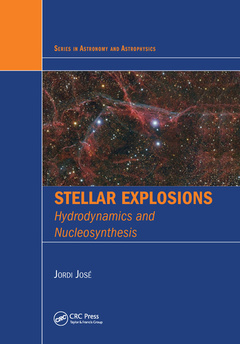Description
Stellar Explosions
Hydrodynamics and Nucleosynthesis
Series in Astronomy and Astrophysics Series
Author: Jose Jordi
Language: English
Subjects for Stellar Explosions:
Keywords
Mass Accretion Rates; Type Ia Supernovae; White Dwarf; X-ray Bursts; Core Collapse Supernovae; Stellar Plasma; Peak Luminosity; NS; Nuclear Reaction Networks; White Dwarf Mass; Light Curve; Presolar Grains; SN 1987A; Nova Outbursts; SiC Grain; Neutron Star Mergers; Hugoniot Curve; Nova Explosions; Hydro Codes; Stellar Explosions; Classical Novae; Graphite Grains; Fe III; Pp Chains; Si Ii
Publication date: 06-2020
· 17.8x25.4 cm · Paperback
Publication date: 12-2015
· 17.8x25.4 cm · Hardback
Description
/li>Contents
/li>Readership
/li>Biography
/li>
Stars are the main factories of element production in the universe through a suite of complex and intertwined physical processes. Such stellar alchemy is driven by multiple nuclear interactions that through eons have transformed the pristine, metal-poor ashes leftover by the Big Bang into a cosmos with 100 distinct chemical species. The products of stellar nucleosynthesis frequently get mixed inside stars by convective transport or through hydrodynamic instabilities, and a fraction of them is eventually ejected into the interstellar medium, thus polluting the cosmos with gas and dust.
The study of the physics of the stars and their role as nucleosynthesis factories owes much to cross-fertilization of different, somehow disconnected fields, ranging from observational astronomy, computational astrophysics, and cosmochemistry to experimental and theoretical nuclear physics. Few books have simultaneously addressed the multidisciplinary nature of this field in an engaging way suitable for students and young scientists.
Providing the required multidisciplinary background in a coherent way has been the driving force for Stellar Explosions: Hydrodynamics and Nucleosynthesis.Written by a specialist in stellar astrophysics, this book presents a rigorous but accessible treatment of the physics of stellar explosions from a multidisciplinary perspective at the crossroads of computational astrophysics, observational astronomy, cosmochemistry, and nuclear physics. Basic concepts from all these different fields are applied to the study of classical and recurrent novae, type I and II supernovae, X-ray bursts and superbursts, and stellar mergers. The book shows how a multidisciplinary approach has been instrumental in our understanding of nucleosynthesis in stars, particularly during explosive events.
Computational Hydrodynamics. Nuclear Physics. Cosmochemistry and Presolar Grains. Classical and Recurrent Novae. Type Ia Supernovae. X-Ray Bursts and Superbursts. Core-Collapse Supernovae. Appendices.
Jordi José is a professor of applied physics and currently the director of the Department of Physics at the Technical University of Catalonia (UPC) in Barcelona. He is also a research associate at the Institute for Space Studies of Catalonia (IEEC). He has been a referee for many research journals and funding agencies (including the U.S. Department of Energy). Dr. José has also been leading a number of international research initiatives, such as the EuroGENESIS program (European Science Foundation). His research focuses on stellar explosions at the crossroads of astrophysics, hydrodynamics, nuclear physics, and cosmochemistry. He is a member of the International Astronomical Union (IAU), the American Physical Society (APS), the Sociedad Española de Astronomía (SEA), and the Societat Catalana de Física, among others.
These books may interest you

Stars and Stellar Processes 76.41 €



